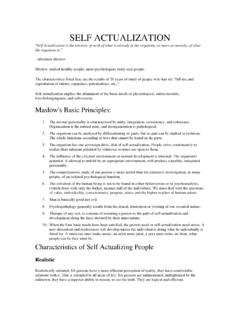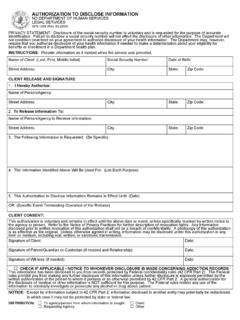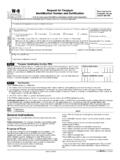Transcription of CMS Manual System Department of Health & Human
1 CMS Manual System Department of Health & Human Services (DHHS) Pub. 100-07 State Operations Provider Certification Centers for Medicare & Medicaid Services (CMS) Transmittal 36 Date: August 1, 2008 SUBJECT: Revisions to Appendix PP Interpretive Guidelines for Long-Term Care Facilities, Tags F325 and F371 I. SUMMARY OF CHANGES: This instruction deletes Tag F326 and incorporates the guidance into Tag F325. It also deletes Tag F370 and incorporates that guidance into F371. NEW/REVISED MATERIAL - EFFECTIVE DATE*: September 1, 2008 IMPLEMENTATION DATE: September 1, 2008 Disclaimer for Manual changes only: The revision date and transmittal number apply to the red italicized material only.
2 Any other material was previously published and remains unchanged. However, if this revision contains a table of contents, you will receive the new/revised information only, and not the entire table of contents. II. CHANGES IN Manual INSTRUCTIONS: (N/A if Manual not updated.) (R = REVISED, N = NEW, D = DELETED) (Only One Per Row.) R/N/D CHAPTER/SECTION/SUBSECTION/TITLE R Appendix PP/ (i)/Nutrition/Tag F325 D Appendix PP/ (i)(2)/Therapeutic Diets/Tag F326 D Appendix PP/ (i)(1)/Approved Food Source/Tag F370 R Appendix PP/ (i)(2)/Food Sanitation/Tag F371 III. FUNDING: Medicare contractors shall implement these instructions within their current operating budgets. IV. ATTACHMENTS: Business Requirements x Manual Instruction Confidential Requirements One-Time Notification Recurring Update Notification *Unless otherwise specified, the effective date is the date of service.
3 F325 (Rev. 36; Issued: 08-01-08; Effective/Implementation Date: 09-01-08) (i) Nutrition Based on a resident s comprehensive assessment, the facility must ensure that a resident-- (i)(1) Maintains acceptable parameters of nutritional status, such as body weight and protein levels, unless the resident s clinical condition demonstrates that this is not possible; and (i)(2) Receives a therapeutic diet when there is a nutritional problem. INTENT: (i) Nutritional Status The intent of this requirement is that the resident maintains, to the extent possible, acceptable parameters of nutritional status and that the facility: Provides nutritional care and services to each resident, consistent with the resident s comprehensive assessment; Recognizes, evaluates, and addresses the needs of every resident, including but not limited to, the resident at risk or already experiencing impaired nutrition; and Provides a therapeutic diet that takes into account the resident s clinical condition, and preferences, when there is a nutritional indication.
4 DEFINITIONS Definitions are provided to clarify clinical terms related to nutritional status. Acceptable parameters of nutritional status refers to factors that reflect that an individual s nutritional status is adequate, relative to his/her overall condition and prognosis. Albumin is the body s major plasma protein, essential for maintaining osmotic pressure and also serving as a transport protein. Anemia refers to a condition of low hemoglobin concentration caused by decreased production, increased loss, or destruction of red blood cells. Anorexia refers to loss of appetite, including loss of interest in seeking and consuming food. Artificial nutrition refers to nutrition that is provided through routes other than the usual oral route, typically by placing a tube directly into the stomach, the intestine or a vein.
5 Avoidable/Unavoidable failure to maintain acceptable parameters of nutritional status: o Avoidable means that the resident did not maintain acceptable parameters of nutritional status and that the facility did not do one or more of the following: evaluate the resident s clinical condition and nutritional risk factors; define and implement interventions that are consistent with resident needs, resident goals and recognized standards of practice; monitor and evaluate the impact of the interventions; or revise the interventions as appropriate. o Unavoidable means that the resident did not maintain acceptable parameters of nutritional status even though the facility had evaluated the resident s clinical condition and nutritional risk factors; defined and implemented interventions that are consistent with resident needs, goals and recognized standards of practice; monitored and evaluated the impact of the interventions; and revised the approaches as appropriate.
6 Clinically significant refers to effects, results, or consequences that materially affect or are likely to affect an individual s physical, mental, or psychosocial well-being either positively by preventing, stabilizing, or improving a condition or reducing a risk, or negatively by exacerbating, causing, or contributing to a symptom, illness, or decline in status. Current standards of practice refers to approaches to care, procedures, techniques, treatments, etc., that are based on research or expert consensus and that are contained in current manuals, textbooks, or publications, or that are accepted, adopted or promulgated by recognized professional organizations or national accrediting bodies.
7 Dietary supplements refers to nutrients ( , vitamins, minerals, amino acids, and herbs) that are added to a person s diet when they are missing or not consumed in enough quantity. Insidious weight loss refers to a gradual, unintended, progressive weight loss over time. Nutritional Supplements refers to products that are used to complement a resident s dietary needs ( , total parenteral products, enteral products, and meal replacement products). Parameters of nutritional status refers to factors ( , weight, food/fluid intake, and pertinent laboratory values) that reflect the resident s nutritional status. Qualified dietitian refers to one who is qualified based upon either registration by the Commission on Dietetic Registration of the American Dietetic Association or as permitted by State law, on the basis of education, training, or experience in identification of dietary needs, planning, and implementation of dietary programs.
8 Therapeutic diet refers to a diet ordered by a Health care practitioner as part of the treatment for a disease or clinical condition, to eliminate, decrease, or increase certain substances in the diet ( , sodium or potassium), or to provide mechanically altered food when indicated. Usual body weight refers to the resident s usual weight through adult life or a stable weight over time. OVERVIEW Nutrients are essential for many critical metabolic processes, the maintenance and repair of cells and organs, and energy to support daily functioning. Therefore, it is important to maintain adequate nutritional status, to the extent possible. Other key factors in addition to intake can influence weight and nutritional status.
9 For example, the body may not absorb or use nutrients effectively. Low weight may also pertain to: age-related loss of muscle mass, strength, and function (sarcopenia),1 wasting (cachexia) that occurs as a consequence of illness and inflammatory processes, or disease causing changes in mental Changes in the ability to taste food may accompany later Impaired nutritional status is not an expected part of normal aging. It may be associated with an increased risk of mortality and other negative outcomes such as impairment of anticipated wound healing, decline in function, fluid and electrolyte imbalance/dehydration, and unplanned weight The early identification of residents with, or at risk for, impaired nutrition, may allow the interdisciplinary team to develop and implement interventions to stabilize or improve nutritional status before additional complications arise.
10 However, since intake is not the only factor that affects nutritional status, nutrition-related interventions only sometimes improve markers of nutritional status such as body weight and laboratory While they can often be stabilized or improved, nutritional deficits and imbalances may take time to improve or they may not be fully correctable in some individuals. A systematic approach can help staff s efforts to optimize a resident s nutritional status. This process includes identifying and assessing each resident s nutritional status and risk factors, evaluating/analyzing the assessment information, developing and consistently implementing pertinent approaches, and monitoring the effectiveness of interventions and revising them as necessary.














